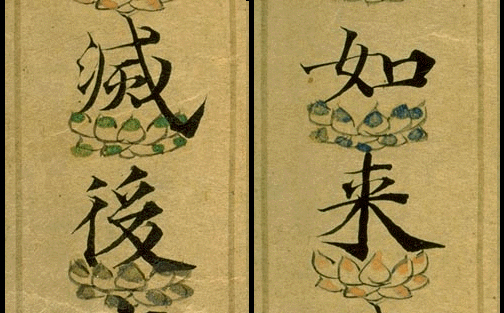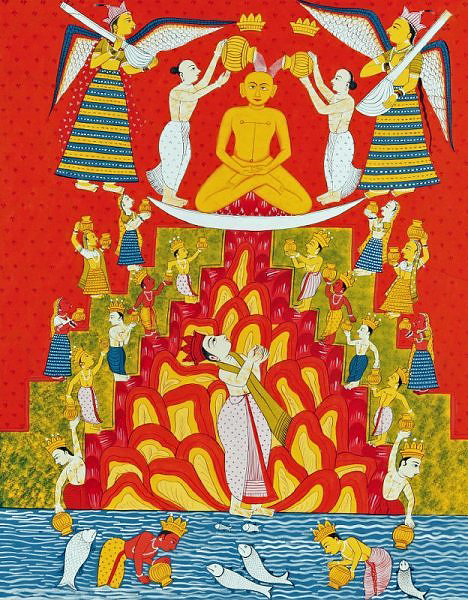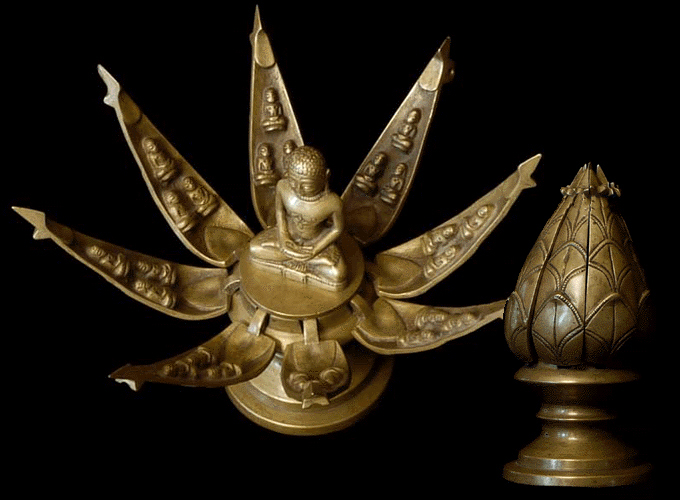
|
|
|
|
BY: SUN STAFF

May 25, 2011 — CANADA (SUN) — A study of the historical, spiritual and cultural elements of Vedic design. Today we continue our discussion on the lotus base, or padmasana, a design motif found in the spiritual arts of many Indian religious traditions. Pictured above is an illustration from a Puranic manuscript, featuring Sri Krsna in His universal form, seated on the lotus pedestal. In Buddhist culture, there is another interesting method of utilizing the lotus as padmasana, in this case employing it as a pedestal for the written characters in a manuscript. In the image below, we see two studies of a Buddhist manuscript known as the Lotus Sutra. In this ancient calligraphic piece, each character of the sutra is treated as a Buddha or Bodhisattva. And like the Buddha Himself, each character is seated on padmasana.

Characters from the Lotus Sutra Each one of the Chinese letters in the Lotus Sutra is seated upon a lotus pedestal to demonstrate the sacredness of every letter of the sutra. The full name of this 12th century manuscript is the Scripture of the Lotus Blossom of the Fine Dharma, in which the Lotus Sutra is one of 28 chapters. Although the Lotus Sutra is a Chinese Buddhist manuscript (which happens to be in the Buddhist collection of the Kyoto National Museum in Japan), the use of the padmasana motif is clearly Vedic in origin. Buddhism emerged from a much more ancient Vaisnava culture, and this is just one of the sacred symbols that was imported into Buddhist tradition. Another interesting example of how the padmasana was adopted by a spin-off religion of Vaisnavism is found in the Jain culture. In the image below, the 'Ablution of Tirthankara', we see the spiritual founder of the sect sitting in yoga posture on a lotus pedestal, with two devotees performing abhiseka.

Ablution of Tirthankara In this case, the lotus pedestal is depicted in a very unusual way. Painted in reds and yellows, the petals of the lotus are presented in an abstract manner that looks somewhat like fire. The shapes of the petals forming this lotus-mountain are also reminiscent of both Buddhist iconography for the lotus, and the Mughal style of painting hills, like those seen in illustrations of Harivamsa. This Jain interpretation of padmasana is made all the more unusual by the layering on of green steps up the sides, which devotees are ascending like they're walking up a hill. Below is another interesting Jain rendition of padmasana, this time in the form of an item of paraphernalia found in both Vaisnava and Buddhist temples. This padmasana is a lotus in the form of a brass device with articulated petals, which can be folded up tight or opened out to reveal the various Jain Tirthankaras. Similar examples of this device are found with Buddha or Visnu in the center.

Jain Folding Lotus Tomorrow we'll continue, with Balinese Vedic temple art depictions of the lotus pedestal.
| |